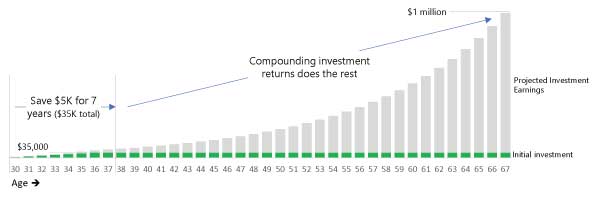The stock market is down significantly this year with many tech companies losing over 30%. Against this dismal backdrop, compounding returns and adding to your investment portfolio may not be top-of-mind.
Yet it behooves you to keep in mind that U.S. equity markets historically return about 10% per year on average over the long term.
Young investors especially should consider the benefits of regularly investing in the stock market given they have 30+ years for their investments to grow. The earlier you start to save and invest, the easier it will be to meet your financial goals.
The power of compounding investment returns is a potent friend over a lifetime. Investors should regularly set aside money toward their long-term financial objectives.
Compounding Returns – Compounding is the process of generating earnings on an asset’s reinvested earnings (Investopedia). For example, if you earn 10% on $10,000, at the end of the year you have $11,000. If you earn 10% again the next year, you end the year with $12,100. Earning the same $1,000 on your original $10,000, plus an additional $100 on the $1,000 earned during the first year.
Illuminating Example
The benefits of investing when you are young is best illustrated by an example.
Assume you are 30 years old. You are trying to decide if you should start saving for retirement.
Consider two options:
- start at age 30 and invest $5,000 per year for 7 years, or
- start at age 37 and invest $5,000 per year for the next 30 years.
Both options achieve a $1 million nest egg at age 67*. Save a little when you are young, or wait to start investing, and play catch-up the rest of your life.

By allowing investment returns to compound over a long timeframe, young investors can generate greater retirement wealth.
401(K) Investing Example
If you work for a technology firm (or any other company) that has a generous 401(k) match, you can further exploit the power of compounding.
Let’s assume you work for a company like Microsoft or Meta that provides a 50% company match. And say you contribute $10,000 per year to your 401(k) account and the company contributes another $5,000 (i.e., matches your deferral at 50%).
This gives you a total retirement account investment of $15,000 per year. And with both Microsoft and Meta Platforms, you are immediately vested in the company’s contribution, which is nice.
Now assuming you invest the entire $15,000 in equities, based on historical returns, you have an expected return of about 10% per year.
Hence, using the same logic as above, with your $10,000 per year for 7 years (from age 30 to 37) and the company’s $5,000 per year match, at retirement age (67) you will have around $3 million in your 401(k).
But why stop there. Once in the habit of deferring $10,000 per year to your 401(k), why stop at age 37. If you maintain this contribution throughout your working life, you will again double your retirement savings. Instead of $3 million at retirement, you would have $6 million.
Let Your Money Do the Work
Investing at any age is a tried-and-true path to creating wealth. But the longer you can take advantage of compounding investment returns, the more generous the reward.
Of course, as we have seen this year, investing in the stock market comes with risk. Over the short term, equity markets can sharply decline.
But for the last 100 years or so in the United States, a broadly diversified investment in the stock market has been a sound long-term investment vehicle. If you can ride out short-term volatility, investors have historically enjoyed a satisfying return on their investments.
*Assumes a 10% annual return; approximately what the S&P 500 Index returned since 1926
This site uses Akismet to reduce spam. Learn how your comment data is processed.
Latest Insights
- How Do Microsoft Employees Invest for Retirement? UpdatedApril 19, 2024No replies
- When is the Best Time to Sell Your RSUs?April 12, 2024No replies
- Your Retirement NumberApril 5, 2024No replies
- How Much Wealth Should You Have by Age 50?March 29, 2024No replies
- Shiller PE – Market Overvalued?March 22, 2024No replies
- Teen Stock Trading – Fidelity Youth AccountFebruary 19, 2024No replies
- Small Business 401(k) Plans – Guide and ProvidersJanuary 24, 2024No replies
- Navigating the 401(k) Questions Maze: Your Complete GuideJanuary 17, 2024No replies
- Cisco Employee Retirement InvestmentsJanuary 10, 2024No replies
- How to Retire with $10 MillionJanuary 3, 2024No replies
- Found Money – Finding a “Lost” 401(k) AccountDecember 20, 2023No replies
- BofA Employee Retirement InvestmentsDecember 6, 2023No replies
- Retirement Plan Savings – Financial Voyeurism Part 5November 29, 2023No replies
- IBM 401(k) Plus Plan Changes!November 22, 2023No replies
- Net Worth Growth – Financial Voyeurism Part 4November 15, 2023No replies



Share Your Thoughts